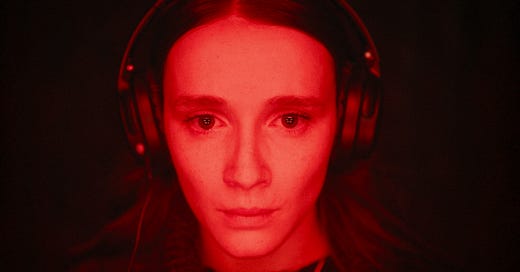The best and worst of internet horror movies
Red Rooms is one of the best films of the year. Afraid is one of the worst. Why are internet-based stories so difficult to tell on the big screen?
Sorry for the radio silence throughout August, folks! A combination of 30th birthday festivities, starting a new job, and some personal life stuff.
The internet is already a dystopian future
It’s really difficult to make a movie about the internet. And actually, it’s even harder to make a scary one. Technological horror tends to date horribly, with today’s terror becoming tomorrow’s bleak mundanity. Most internet horror from the last few decades is less scary than just opening the Twitter app in 2024. But when stories about the internet come from the minds of creators who really understand the online world, the rewards are huge. That’s why French-Canadian auteur Pascal Plante is currently receiving rave reviews and cult success for his new thriller Red Rooms.
To begin with, Red Rooms looks and feels like any other thriller inspired by the true crime wave. We watch the opening of a court case1 in which a troubled-looking man is accused of murdering three teenage girls and torturing them, before and after death, for a paying audience. Plante’s camera repeatedly lingers on a young woman in the public gallery — Juliette Gariépy’s inscrutable Kelly-Anne — but is she one of the alleged murderer’s bizarre army of devoted groupies, or someone who wants to see him locked up?
So far, so analogue. But when Kelly-Anne gets home from the trial, she wordlessly and dispassionately finds the home address of one of the victims’ mothers by scrutinising news footage and then locates her email password via a searchable catalogue of user data breaches. It’s completely chilling how easy it all is, with Plante smartly allowing the audience to watch the entire process in the eerie silence of Kelly-Anne’s glossy, glass-fronted apartment.
The best movies about the internet understand that, for those who have always lived in a connected world, it isn’t a service you actively choose to access. It’s more like the waves constantly lapping at the shores of your personal island, or the wind gusting around you — unavoidable and ever-present. Much like Jane Schoenbrun’s exceptionally bizarre We're All Going to the World's Fair, which is the best ever depiction of irony-pilled online culture, Red Rooms explores the ways in which digital communities allow people to hide themselves and conceal their true feelings so efficiently that even they lose track of who they are and what they believe.
Kelly-Anne’s motivations are murky and unclear throughout the movie. While she forms a friendship in the public gallery with Clémentine (Laurie Babin) — an unashamed believer in the alleged killer’s innocence — she’s careful not to commit to either side of the argument. It’s possible that even she doesn’t know how she feels, or that her own hyper-fixation on the case is as much about the joy of the mystery as about actually wanting to advocate for her perception of the truth.
Everything that Kelly-Anne does is facilitated and encouraged by the internet, from her initial fascination with the case to the grotesque dark web auction she later takes part in. And this isn’t a story taking place against the backdrop of some horrific near-future dystopia; this is the internet as we know it today. That’s what gives Red Rooms its weird, dissociative impact and, therefore, its intense narrative power. Anyone who has spent any part of their life as a denizen of internet communities will recognise how close this sort of darkness can feel to the mainstream.
Contrast all of that with the new Blumhouse horror movie Afraid, written and directed by Chris Weitz of American Pie and Twilight fame. It tells the story of a marketing man (John Cho), who is given a hyper-advanced smart assistant — like Alexa on steroids — to test out with his family. You know how the story goes from there. Things start great, but then the AI starts to go into business for itself.
And you know what? It’s absolute rubbish. Like Red Rooms, it has an odd and uncanny feel. Here, that mood comes not from elite-level filmmaking craft but from a script that honestly sounds like it has come from a generative AI model. Every line of dialogue is stilted, every theme is spelled out in laboriously literal terms, and the characters never feel even close to human.
Like so much tech-based horror, Afraid falls into the trap of thinking that we need to amplify the power of the technology to make it scary. But movies like Red Rooms show the world in which we already live is terrifying enough — a world in which machines and algorithms can manipulate us in more subtle, insidious ways.
Afraid just keeps giving its central machine more and more power until any grip on reality is long gone, with the grip of its terror following it. In an attempt to mimic the success of M3GAN — which was an exercise in meme culture and comedy rather than bona fide chills — Blumhouse has made one of the year’s most yawn-worthy movies.
All of this just underscores the genius of Red Rooms and the importance of stories about the internet being made by those who truly understand it. While something like Afraid feels like Abraham Simpson yelling at an iCloud, Red Rooms is an immersive journey into the very real grubbiness of the world we have allowed technology to build around us. The internet is even scarier without Hollywood’s sensational instincts getting in the way.
Red Rooms and Afraid are both in UK cinemas now.
I could write a whole other essay about the genius of the way Red Rooms shows the mundanity and clinical atmosphere of a court room, using it to make the horrifying details of the crimes even more shocking. It’s a masterful bit of filmmaking.





